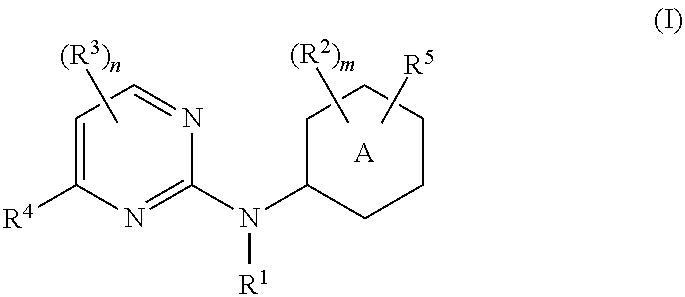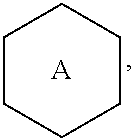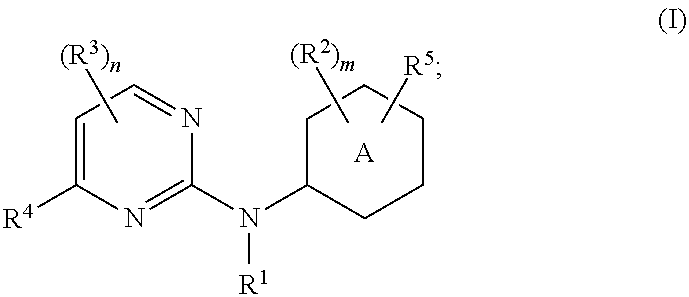Pyrimidine-2-amine compounds and their use as inhibitors of jak kinases
a technology of pyrimidine and amine, which is applied in the direction of drug compositions, immune disorders, extracellular fluid disorders, etc., can solve the problems of disrupting normal cellular processes needed for cell survival
- Summary
- Abstract
- Description
- Claims
- Application Information
AI Technical Summary
Benefits of technology
Problems solved by technology
Method used
Image
Examples
synthetic example 1
4-(6-(N,N-dimethylamino)pyridin-3-yl)-N-(3-methyl-4-((1S,4S)-5-methyl-2,5-diazabicyclo[2.2.1]heptan-2-yl)phenyl)pyrimidin-2-amine
[1434]
[1435]A. 2-Chloro-4-(6-dimethylaminopyridin-3-yl)pyrimidine (35 mg, 0.15 mmol) and 3-methyl-4-[(1S,4S)-5-methyl-2,5-diazabicyclo[2.2.1]heptan-2-yl]phenylamine (55 mg, 0.25 mmol) in 1.5 mL 2-propanol with TFA (4 drops) were heated at 100° C. for 12 h in a sealed tube. Reaction progress was monitored by LC / MS. Upon completion, the reaction mixture was concentrated and purified by preparative HPLC. The pure concentrate, obtained after purification, was exposed to aq. K2CO3 solution to neutralize any acid remaining. The solid formed upon exposure to aq. K2CO3 solution was collected by filtration, washed with water and dried to provide 4-(6-(N,N-dimethylamino)pyridin-3-yl)-N-(3-methyl-4-((1S,4S)-5-methyl-2,5-diazabicyclo[2.2.1]heptan-2-yl)phenyl)pyrimidin-2-amine, compound #1, as an off-white solid (35 mg, 56%). 1H NMR (DMSO-d6): δ 9.13 (s, 1H), 8.81 (s, ...
synthetic example 2
4-(6-(N,N-dimethylamino)pyridin-3-yl)-5-methyl-N-(3-methyl-4-((1S,4S)-5-methyl-2,5-diazabicyclo[2.2.1]heptan-2-yl)phenyl)pyrimidin-2-amine
[1437]
[1438]Following substantially one of the procedures as described in SYNTHETIC EXAMPLE 1 and making non-critical variations in the experimental parameters and using the appropriately substituted starting materials and reagents, 4-(6-(N,N-dimethylamino)pyridin-3-yl)-5-methyl-N-(3-methyl-4-((1S,4S)-5-methyl-2,5-diazabicyclo[2.2.1]heptan-2-yl)phenyl)pyrimidin-2-amine, compound #2, was obtained; 1H NMR (DMSO-d6): δ 9.04 (s, 1H), 8.48 (d, 1H, J=1.8 Hz), 8.22 (s, 1H), 7.89 (dd, 1H, J=2.0 and 8.8 Hz), 7.45 (app d, 1H, J=8.8 Hz), 7.40 (s, 1H), 6.71 (t, 2H, J=8.8 Hz), 3.84 (s, 1H), 3.18 (d, 1H, J=9.0 Hz), 3.11 (d, 1H, J=9.0 Hz), 3.08 (s, 6H), 2.72 (d, 1H, J=9.0 Hz), 2.64 (d, 1H, J=9.0 Hz), 2.25 (s, 3H), 2.23 (s, 3H), 2.16 (s, 3H), 1.75 (d, 1H, J=9.0 Hz), 1.67 (d, 1H, J=9.0 Hz); LCMS: purity: 99%; MS (m / e): 430 (MH+).
synthetic example 3
4-(6-(N,N-dimethylamino)pyridin-3-yl)-5-trifluoromethyl-N-(3-methyl-4-((1S,4S)-5-methyl-2,5-diazabicyclo[2.2.1]heptan-2-yl)phenyl)pyrimidin-2-amine
[1439]
[1440]Following substantially one of the procedures as described in SYNTHETIC EXAMPLE 1 and making non-critical variations in the experimental parameters and using the appropriately substituted starting materials and reagents, 4-(6-(N,N-dimethylamino)pyridin-3-yl)-5-trifluoromethyl-N-(3-methyl-4-((1S,4S)-5-methyl-2,5-diazabicyclo[2.2.1]heptan-2-yl)phenyl)pyrimidin-2-amine, compound #3, was obtained; 1H NMR (DMSO-d6): δ 9.91 (s, 1H), 8.68 (s, 1H), 8.34 (s, 1H), 7.74 (app d, 1H, J=8.8 Hz), 7.40-7.37 (m, 2H), 6.73 (d, 1H, J=8.8 Hz), 6.71 (d, 1H, J=8.8 Hz), 3.90 (s, 1H), 3.18 (s, 2H), 3.08 (s, 6H), 2.72 (d, 1H, J=9.0 Hz), 2.65 (d, 1H, J=9.0 Hz), 2.25 (s, 3H), 2.17 (s, 3H), 1.77 (d, 1H, J=9.0 Hz), 1.67 (d, 1H, J=9.0 Hz); LCMS: purity: 99%; MS (m / e): 484 (MH+).
PUM
 Login to View More
Login to View More Abstract
Description
Claims
Application Information
 Login to View More
Login to View More - R&D
- Intellectual Property
- Life Sciences
- Materials
- Tech Scout
- Unparalleled Data Quality
- Higher Quality Content
- 60% Fewer Hallucinations
Browse by: Latest US Patents, China's latest patents, Technical Efficacy Thesaurus, Application Domain, Technology Topic, Popular Technical Reports.
© 2025 PatSnap. All rights reserved.Legal|Privacy policy|Modern Slavery Act Transparency Statement|Sitemap|About US| Contact US: help@patsnap.com



